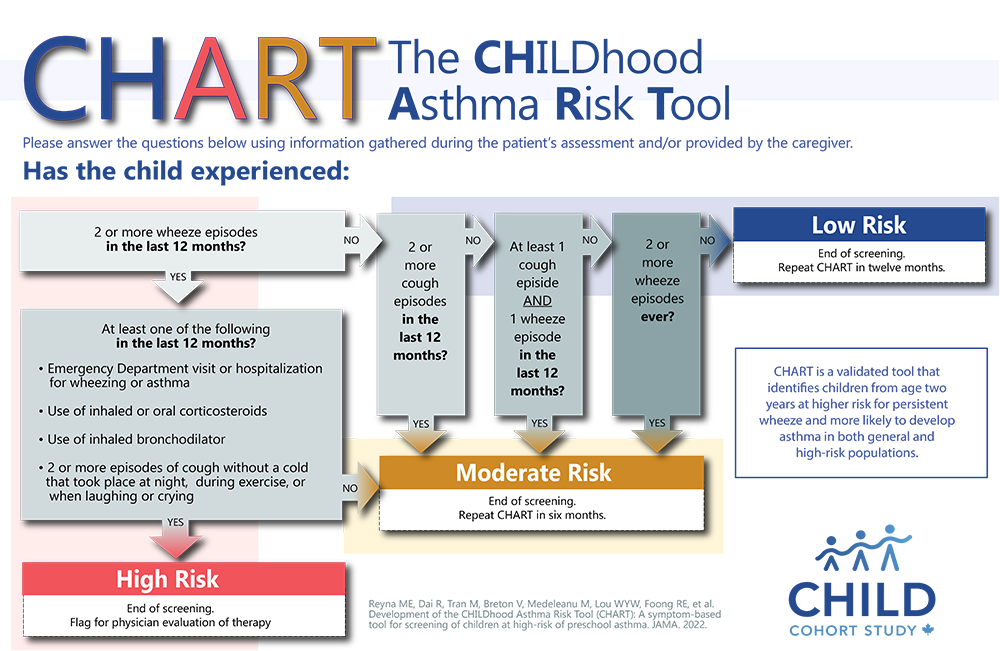Screening tool could help primary caregivers to predict asthma risk early
Summary:
A team of researchers has developed a symptom-based screening tool that detects asthma risk in children as young as two years of age.
A team of researchers from the CHILD Cohort Study has developed a new symptom-based screening tool that detects asthma risk in children as young as two years of age. The efficacy of the tool — the CHILDhood Asthma Risk Tool, or CHART — is detailed in a study published today in the Journal of the American Medical Association (JAMA).
“Asthma affects nearly 330 million people worldwide, carries a heavy health-care cost, and is the leading cause of hospitalization among kids in Canada — especially kids under five,” says Dr. Padmaja Subbarao, co-senior author, Senior Scientist, Translational Medicine at The Hospital for Sick Children (SickKids) and Director of CHILD.
“Earlier detection of this condition will allow doctors to treat kids sooner, so they will suffer less and avoid going to the hospital, thus also lowering costs to the health-care system.”
The tool, CHART, categorizes children’s risk of future asthma and persistent symptoms as ‘High,’ ‘Moderate’ or ‘Low,’ based on information reported before age three. The tool recommends follow-up actions for each group. In the study, CHART was applied to data from 2,354 children participating in CHILD, a longitudinal research study launched in 2008 that has been following the physical, social and cognitive development of nearly 3,500 Canadian children from before birth. Senior authors on the study include Subbarao and CHILD Founding Director Dr. Malcolm Sears.
From information about the children’s wheezing and coughing episodes, use of asthma medications, and related hospital visits at three years of age, CHART was able to predict with 91 per cent accuracy which of these kids would have persistent wheeze — a key indicator of asthma — by age five. Of those children evaluated by CHART to be at high risk of asthma at age three, 50 per cent were diagnosed by in-study physicians as having asthma by five years of age.

“One reason asthma often goes undetected in young children is because most conventional asthma tests are difficult to perform in children, time consuming and invasive, involving skin pricks and blood-taking, so many patients and doctors choose to avoid them,” notes the study’s co-first author, Myrtha Reyna-Vargas, who is an M.Sc. and a biostatistician at SickKids.
“Other conventional tests can also require appointments with specialists and the use of specialized equipment to test lung function, with associated costs. The beauty of CHART, the new tool we have developed, is that it can be used by family doctors or nurses in a low-resource primary care setting. It is non-invasive; it can be done on-the-spot and in-the-moment; it is cost-free and it requires no special equipment. Now that we have shown CHART’s benefits in the CHILD study, we are working towards validating its use prospectively in clinical practice.”
Overall, CHART was found to be more accurate at predicting persistent wheeze, asthma, and related health care usage than other standard diagnostic methods, including physician assessments and the conventional asthma test known as the modified Asthma Predictive Index (mAPI).
The study’s findings using CHILD data were validated by testing CHART’s performance against data from two additional cohort studies: the Canadian CAPPS Cohort and the Australian Raine Study. Not only did CHART also perform well within these cohorts, but—from data available through the CAPPS Cohort—it was shown to be effective when applied to data from children as young as two years of age.
“We designed CHART to be a pragmatic screening tool for the use of busy primary caregivers,” says co-first author Ruixue (Vera) Dai, an M.Sc. and a biostatistician at SickKids.
“With easily gathered information, CHART could be incorporated into electronic medical records as a routine assessment. These kids can then be evaluated more closely, their conditions treated and managed better, and many hospitalizations avoided.”

